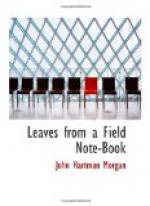I grew more and more interested. If this was a “correctional” offence, the magistrate must in the ordinary course of things commit the prisoner to a chambre de conseil, thereafter to take his trial before a Tribunal Correctionnel. But chamber and tribunal were scattered to the four corners of the earth.
Here, I felt sure, the whole proceedings must collapse and the magistrate be sadly compelled to admit his impotence. The magistrate, however, appeared in nowise perturbed, nor did he for a moment relax his authoritative expression. He was turning over the pages of the Code d’Instruction Criminelle, glancing occasionally at a now wholly penitent prisoner trembling before the majesty of the law. At last he spoke. “I will deal with you,” he said with an air of indulgence, “under Chapter VIII. of the Code. You will be bound over to come up for judgment at the end of the war if called upon. You will deposit a cautionnement of twenty francs. And now, gentlemen, we are at your service.”
“Fiat justitia ruat coelum,” whispered A—— to me, as the prisoner, deeply impressed, opened a leather purse and counted out four greasy five-franc notes.
FOOTNOTE:
[27] Defamation. It is a misdemeanour according to Belgian law.
XXVII
HIGHER EDUCATION
British Headquarters must, I think, be the biggest Military Academy in the world. It has its Sandhurst and its Woolwich and even its Camberley. It ought long ago to have been incorporated by Order in Council as a University with Sir John French as Chancellor. It has more schools in the Art of War than I can remember, and every School has an Instructor who deserves to rank as a full-time Professor. To graduate in one of those schools you must get a fortnight’s leave from your trenches or your battery, at the end of which time you return to do a little post-graduate work of a very practical kind with the aid of a machine-gun or a trench-mortar. At the beginning of the war higher education at G.H.Q. was somewhat neglected, and the company officer who desired to improve himself in the lethal arts had to be content with private study. Company officers went in for applied chemistry by making flares out of a test-tube full of water, delicately balanced in a bully-beef tin containing sodium. The tins were tied to the barbed-wire entanglements in front of our trenches, and when the stealthy Hun, creeping on his stomach, bumped against the wire the test-tube overflowed into the tin and a lurid patch of greenish flame revealed the clumsy visitor to our look-outs. That was before we were supplied with calcium flares. Then, too, the sappers went in for experimental research by making trench-mortars out of old stove-pipes.




